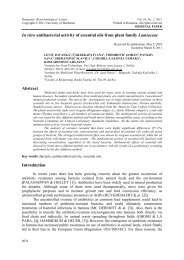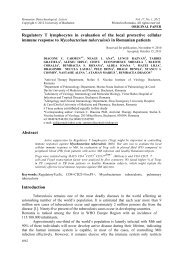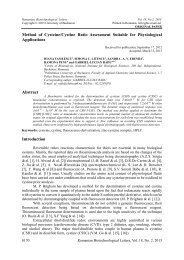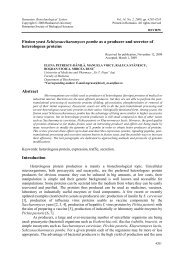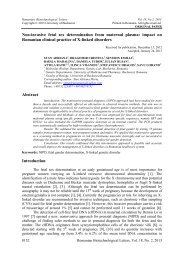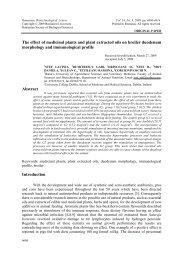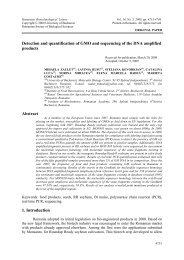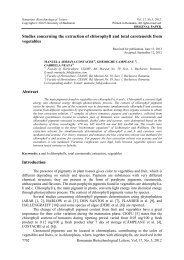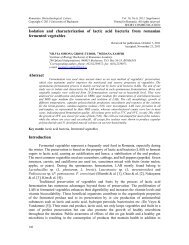A Modified ASM3 Model for a Trickling Filter Abstract ... - Rombio.eu
A Modified ASM3 Model for a Trickling Filter Abstract ... - Rombio.eu
A Modified ASM3 Model for a Trickling Filter Abstract ... - Rombio.eu
You also want an ePaper? Increase the reach of your titles
YUMPU automatically turns print PDFs into web optimized ePapers that Google loves.
Roumanian Biotechnological Letters Vol. 13, No. 5, supplement, 2008, pp. 39-48Copyright © 2008 Bucharest UniversityPrinted in Romania. All rights reservedRoumanian Society of Biological SciencesORIGINAL PAPERA <strong>Modified</strong> <strong>ASM3</strong> <strong>Model</strong> <strong>for</strong> a <strong>Trickling</strong> <strong>Filter</strong><strong>Abstract</strong>Received <strong>for</strong> publication, August 28 , 2008Accepted, September 22, 2008MARIAN BARBU, SERGIU CARAMAN, EMIL CEANGĂ“Dunarea de Jos” University of Galati, Faculty of Electrical Engineering,Galati 800008, Domneasca 47, Romania, Phone/Fax: +40236470905e-mail: {Marian.Barbu; Sergiu.Caraman; Emil.Ceanga} @ugal.roThis paper aims to determine and analyze a model <strong>for</strong> a biological filter that is part of anintensive recycled aquaculture plant. The biological filter used in this plant is a biofilm filter oftrickling type. In this filter only the nitrification processes take place. In order to determine a modelthat can be used in real-time control a global model <strong>for</strong> the nitrification filter is recommended.Consequently, a modified <strong>ASM3</strong> (Activated Sludge <strong>Model</strong> No. 3) model is proposed in order toinclude only the nitrification processes and to consider the nitrite and the nitrate as distinct statevariables. In this model the quality variables are the ammonium and the nitrite concentrations, thecommand variables are the aeration and recycled volume and the disturbance variable is theammonium concentration from the fish tanks. The simulation results of the model are also presentedin the paper. These results are obtained <strong>for</strong> different functioning conditions of the technologicalplant. The simulation results show that the model offers a good description of the main statevariables: ammonium, nitrite and nitrate.Keywords: Activated sludge modeling, Process modelling and control, Nitrification, <strong>Trickling</strong>filter.IntroductionThe modern technologies <strong>for</strong> fish super-intensive growth ask <strong>for</strong> water recycled plants thatrequire the use of high per<strong>for</strong>mance specific systems <strong>for</strong> water treatment [1]. These systemsaim the ammonium removal from the wastewater so that the maximum limit,1mgN/l, be notexceeded. This fact, together with the existence of large flows that have to be treated and thesmall spaces existent <strong>for</strong> treatment is the reason <strong>for</strong> that, in the case of these systems, theoption taken into consideration was the use of particular solutions <strong>for</strong> wastewater treatment.Thus a combination of biological filters with biofilm <strong>for</strong> the nitrification process and chemicalfilters <strong>for</strong> the denitrification process is used. The nitrification filters with biofilm have theadvantage that offer a higher efficiency than the classic solution <strong>for</strong> wastewater treatment, butthe modelling and control problem of these systems becomes more complex.The mathematical modelling of the systems with biofilm leads to extremely complex models,the biofilm being treated as a dynamic system with distributed parameters with respect to twospatial coordinates [2]: a) the coordinate corresponding to the trace of the processed water andb) the spatial coordinate corresponding to the processes from biofilm. Obviously, the scales ofthe two spatial coordinates differ through many size orders. An alternative to the local modelsthat are very complex, based on the micrometric scale description of the processes frombiofilm, is the consideration of biofilter model in which the nitrification processes are globallytreated. In this case, the existent models <strong>for</strong> the classic wastewater treatment can be used. The39
MARIAN BARBU, SERGIU CARAMAN, EMIL CEANGĂmost known models in the literature are ASM 1, ASM2, ASM 2d and <strong>ASM3</strong>. These modelsare proposed by IWA (International Water Association) [3]. An improved variant of themodels mentioned be<strong>for</strong>e is <strong>ASM3</strong>_2N, in witch the ammonium decomposition in thenitrification-denitrification processes is treated on the two components, nitrites and nitrates[4].Materials and methodsAn intensive aquaculture recycled system contains the following units:- The unit <strong>for</strong> the fish growth: the organic substance produced by the fish metabolism isdecomposed through an aerobe process by the heterotrophs bacteria in simpler organicproducts, the final product being the ammonium. The goal followed by the wastewatertreatment system is to ensure the removal of the organic substances and the intermediaryproducts (the ammonium compounds);- The mechanic filter: it aims to remove the big particles existent in the water eliminatedfrom the fish growth tanks;- The biologic nitrification filter: a nitrification biofilm of „trickling” type is considered inthe paper. Regardless the configuration of the filter, the nitrification is achieved in twooxidation phases. In the first phase, the ammonium is oxidized by the autotrophs bacteria(Nitrosomonas), in nitrites – ( NO − 2), through the reaction (1):+ 3 Ammonium oxidizersNH4 2NO2 2H H2O 66kcal/M2 O− ++ ⎯⎯⎯⎯⎯⎯→ + + + (1)The nitrites are oxidized by another category of autotrophs bacteria (Nitrobacter), innitrates – ( NO − 3), through the reaction (2):− 1 Nitrite oxidizersNO2 2NO318kcal/M2 O−+ ⎯⎯⎯⎯⎯→ + (2)- The denitrification filter: it is used to trans<strong>for</strong>m the nitrate resulted in the nitrification filterin gaseous ammonium. Within the plant studied in the paper, the denitrification filter isbased on chemical principles and it has a constant efficiency.Table 1. Process rate equations <strong>for</strong> the <strong>ASM3</strong>_2N modified modelj Process Rate equation rj1 Hydrolysis XS/ XHkHXHKX + ( XS / XH)2 Aerobic storage of S SSO S2SkSTOXHKO + S2 OK2 S+ SS3 Aerobic growthSO S2 NH X /4STOXHμHKO + S ( / )2 OK2 NH+ S4 NHK4 STO+ XSTO XH4 Aerobic endogenous respirationSO2bH , OX2HKO+ S2 O25 Aerobic respiration of X SSTOO2bSTO,OX2STOK + SO2 O2XH40Roum. Biotechnol. Lett., Vol. 13, No. 5, supplement, 39-48 (2008)
A <strong>Modified</strong> <strong>ASM3</strong> <strong>Model</strong> <strong>for</strong> a <strong>Trickling</strong> <strong>Filter</strong>6 Aerobic growth ofns7 Aerobic growth ofnb8 Aerobic endogenous respirationof Xns9 Aerobic endogenous respirationof XnbSX O2 NH4μnsXnsKA, O+ S2 OK2 A,NH+ S4 NH4X SO K2 I,NHS4 NO2μnbKA, O+ S2 OK2 I , NH+ S4 NHK4 NO+ S2 NO2bbns,O2nb,O2KKSO2+ SAO , 2 O2SO2+ SAO , 2 O2XXnsnbSXnbThe model proposed in the paper is a modified variant of the model <strong>ASM3</strong>_2N. Thus, takinginto account the fact that within the intensive aquaculture plant there is only an aerobebiologic filter, a model in which are included the aerobe phenomena containing in the modelASM_2n is proposed. It results a model in which only 9 phenomena that take place in thefilter and 12 state variables are considered. The phenomena considered in the model, togetherwith the corresponding reaction rates are presented in Table 1. Table 2 shows the values of thekinetic parameters used in the model.Table 2. Kinetic and stoichiometric parameters values used in the <strong>ASM3</strong>_2N modified modelSymbol Characterization Value Unitsk Hydrolysis rate constant 3 gCOD (gCOD−) dHKX Hydrolysis saturation constant 1kSTOStorage rate constant 7.38KO 2Saturation constant <strong>for</strong>KSμHSO 20.1Saturation constant <strong>for</strong> SS3Heterotrophic maximum growth rate <strong>for</strong>XHXSXHgCOD (gCOD )XSXH1 −1−1gCOD (gCOD ) dXSgO m −23gCOD mS S11 d −KNH 4Saturation constant <strong>for</strong> SNH 40.01gNm −3KSTOSaturation constant <strong>for</strong> XSTO1 gCODX(gCOD )STOXHAerobic endogenous respiration rate ofb1H , O2X0.1 d −Hb Aerobic respiration rate of X1STO 0.2STO,O2μnsMaximum growth rate ofnsd −X 0.631313KA,O Oxygen saturation <strong>for</strong> nitrifiers 0.5gO22m −KAmmonium substrate saturation <strong>for</strong>A,NH2gNm −34nitrifiersμnbMaximum growth rate of X1nb 1.0476 d −−KI , NH Ammonia inhibition of nitrite oxidation 5gNH44Nm−KNO 2Saturation constant <strong>for</strong> SNO 20.5 gNO2Nmd −XH−3−3−3−1 −1−1Roum. Biotechnol. Lett., Vol. 13, No. 5, supplement, 39-48 (2008) 41
MARIAN BARBU, SERGIU CARAMAN, EMIL CEANGĂbbns,O2nb,O2Aerobic endogenous respiration rate ofXAerobic endogenous respiration rate ofXnsnb10.061 d −10.061 d −The model of the process is determined based on the stoichiometric matrix corresponding tothe 9 phenomena and the 12 state variables mentioned in Table 2. Further on is presented thesignificance of the state variables: SO 2- dissolved oxygen concentration, S S- readilybiodegradable substrates concentration, SNH 4- ammonium concentration, SNO 2- nitritenitrogen concentration, SNO 3- nitrate nitrogen concentration, S I- soluble inert organicsconcentration, XI- inert particulate organics concentration, X S- slowly biodegradablesubstrates, XH- heterotrophic biomass, X STO- organics stored by heterotrophs, X ns-ammonia-oxidizing autotrophs, X nb- nitrite-oxidizing autotrophs. The stoichiometricparameter values that appear in the model are presented in Table 4.On the basis of the reaction rates presented in Table 1, the stoichiometric matrix described inTable 3 and the parameters values given in Tables 2 and 4, the model of the nitrification filter canbe built. The model that results is one in which the evolution of the state variables,considering the closed system, without inputs and outputs is described. In this model theevolution of the state variables is determined only by the reaction rates, corresponding to the 9aerobe phenomena presented in Table 1.42Roum. Biotechnol. Lett., Vol. 13, No. 5, supplement, 39-48 (2008)
VariableOProcess 2S SS1 - 1−23f SIA <strong>Modified</strong> <strong>ASM3</strong> <strong>Model</strong> <strong>for</strong> a <strong>Trickling</strong> <strong>Filter</strong>Table 3. Stoichiometric matrix of the <strong>ASM3</strong>_2N modified modelSNH 4−iNS,(1 − f )S S−If i + iSI N, SI N,XSYSTO, O− 1 -12NS , S− Y HO ,- i2NBM ,1 (1/ )SNO 2- -SNO 3SIXIXSXHXSTOXnsXnbfS I- -1 - - - -i - - - - - -− - - - - - 1Y - -STO,O21/ YH , O2− - -4 fX I− 1- iNBM ,− fXiI NX , - - - fIX I- -1 - - -5 -1 - - - - - - - - -1 - -6 1 − (3.43/ Y ns) - −(1/ Yns) − iN , BM 1/ Yns - - - - - - 1 -7 1 − (3.43/ Y nb) - − i NBM , − 1/ Ynb1/ Ynb- - - - - - 18 fX I− 1- iNBM ,− fXiI NX , I- - -9 fX I− 1- iNBM ,− fXiI NX , I- - -fX I- - - -1 -fX I- - - - -1Table 4. Stoichiometric parameters values used in the <strong>ASM3</strong>_2N modified modelSymbol Characterization Value UnitsYSTO,OAerobic yield of stored product <strong>for</strong> SS0.85 gCOD (gCOD )H , O22Y Aerobic yield of heterotrophic biomass 0.835fX IProduction of XIin endogenous respiration 0.2YnsAerobic yield of Xns0.1YnbAerobic yield of Xnb0.14fS IProduction of SIin hydrolysis 0iNS , N content of SSS0.03iNS , N content of SII0.01iN, XN content of XSS0.04iNBM ,N content of biomass ( XH, Xnsand Xnb) 0.07iN, XN content of XII0.02XSTOgCOD (gCOD )XH−1SS−1XSTO−1XBM−1NO2−1NO3−1XS−1gCODX(gCOD )IgCOD (gN )X nsgCOD (gN )X nbgCOD (gCOD )SIgN(gCOD )S SgN(gCOD )S IgN(gCOD )X SgN(gCOD )X BMgN(gCOD )X I−1−1−1−1Roum. Biotechnol. Lett., Vol. 13, No. 5, supplement, 39-48 (2008) 43
MARIAN BARBU, SERGIU CARAMAN, EMIL CEANGĂThe complete model of the nitrification filter assumes the consideration of some supplementaryelements besides the reaction rates: the inflow (the water loaded with ammonium provided by thetanks <strong>for</strong> the fish growth), the output flow (the water that goes out from the trickling filter andenters in the denitrification filter) and the biofilm aeration (the air is introduced <strong>for</strong> achieving anincreasing of the oxygen concentration from the wastewater, that is to accelerate the oxidizingprocesses). The model will have the expression (3) <strong>for</strong> all the equations, excepting the one of thedissolved oxygen.dx 1= ( Qxin in− Qoutx+ rV)(3)dt Vwhere x is the state variable, V - the trickling filter volume, Q in- the inflow, x in- theconcentration of the component x in the influent, Qout- the outflow and r represents the vector ofthe conversion rates. For making easy the model implementation it assumes that the output flowfrom the biofilm is equal to the input one, neglecting the hydraulic dynamics.For the dissolved oxygen concentration the following equation is used:dSO21= ( QSOin 2, in− Qout SO2 + rV)+ αWSO (2, sat− SO2)(4)dt Vwhere: α is the oxygen transfer rate, W - aeration rate and SO2is the saturation concentration ofthe dissolved oxygen concentration.Results and DiscussionThe nitrification process with biofilm of trickling type considered in the present paper has as inputvariables the biofilm aeration rate, the recycling flow from the intensive aquaculture system ( thebiofilm inflow) and the ammonium concentration from the inflow. The first two are commandvariables that can be modified by the operator aiming to improve the effluent quality, while thethird is a disturbance variable those evolution depends on the following factors: the quantity and theage of the fish from the growth units, the food quantity, the temperature etc. The quality variables ofthe process are the ammonium and nitrites concentrations at the biofilter output. Further on theresults obtained by numerical simulation of the model proposed in the previous section arepresented. The simulations have shown how the variation of the command variables and of thedisturbances influences the evolution of the quality variables.The first simulation had in view the study of the influence of the aeration on the nitrificationprocesses. Figure 1 presents the results of the simulation. The following cases were considered:W = 40 lpm (solid line), W = 20 lpm (dashed line) and W = 2 lpm (dotted line). In the simulationthe dissolved oxygen concentration from the influent has been considered equal to zero, thenecessary oxygen <strong>for</strong> the nitrification processes being provided only through aeration. It can be alsoobserved that in the case of an insufficient aeration (the dissolved oxygen concentration is closed tozero), the oxidizing processes cannot take place, their efficiency being very small (the ammoniumconcentration in the effluent is almost equal to the one from the inflow: 1 mgN/l . Along with thegrowth of the dissolved oxygen concentration, the process efficiency also increases very much inthe presence of the aeration. In order to establish more clearly the importance of the dissolvedoxygen concentration from the wastewater on the nitrification processes a new simulation in whichthe dissolved oxygen from the influent was varied and it has been considered that there is notaeration has been done. Figure 2 presents the simulation results. They have been obtainedconsidering the following cases: SO2, in= 4mgO2/l(solid line), SO2, in= 2mgO2/l(dashed line) andSO2, in= 0mgO2/l(dotted line). It results very clearly that the nitrification processes could have ahigh efficiency only in the case when a sufficient dissolved oxygen concentration is assured. In both44Roum. Biotechnol. Lett., Vol. 13, No. 5, supplement, 39-48 (2008)
A <strong>Modified</strong> <strong>ASM3</strong> <strong>Model</strong> <strong>for</strong> a <strong>Trickling</strong> <strong>Filter</strong>cases it can be observed that if the ammonium concentration from the effluent decreases, than thenitrites and nitrates concentrations increase, the most significant being the nitrate one.Dissolveld oxygen [gO2/mc]32100 0.1 0.2 0.3Ammonium [gN/mc]10.80.60.40 0.1 0.2 0.3Nitrite nitrogen [gN/mc]Ammonia autotrophs [gCOD/mc]0.20.150.10.0520.420.320.220.100 0.1 0.2 0.3200 0.1 0.2 0.3Nitrate nitrogen [gN/mc]Nitrite autotrophs [gCOD/mc]0.80.60.40.225.325.225.100 0.1 0.2 0.325Time [days]24.90 0.1 0.2 0.3Figure 1. The influence of the aeration on the nitrification processes: W = 40 lpm - solid line, W = 20 lpm - dashedline and W = 2lpm - dotted lineDissolveld oxygen [gO2/mc]32100 0.1 0.2 0.3Ammonium [gN/mc]10.80.60.40 0.1 0.2 0.3Nitrite nitrogen [gN/mc]Ammonia autotrophs [gCOD/mc]0.10.0520.420.320.220.100 0.1 0.2 0.3200 0.1 0.2 0.3Nitrate nitrogen [gN/mc]Nitrite autotrophs [gCOD/mc]0.80.60.40.225.325.225.100 0.1 0.2 0.325Time [days]24.90 0.1 0.2 0.3Figure 2. The influence of the dissolved oxygen concentration on the nitrification processes: SO2, in= 4mgO2/l- solidline, SO2, in= 2mgO2/l- dashed line and SO2, in= 0mgO2/l- dotted lineRoum. Biotechnol. Lett., Vol. 13, No. 5, supplement, 39-48 (2008) 45
MARIAN BARBU, SERGIU CARAMAN, EMIL CEANGĂDissolveld oxygen [gO2/mc]543210 0.1 0.2 0.3 0.4 0.5Ammonium [gN/mc]10.500 0.1 0.2 0.3 0.4 0.5Nitrite nitrogen [gN/mc]Ammonia autotrophs [gCOD/mc]0.20.150.10.0520.500 0.1 0.2 0.3 0.4 0.5212019.50 0.1 0.2 0.3 0.4 0.5Nitrate nitrogen [gN/mc]Nitrite autotrophs [gCOD/mc]10.525.500 0.1 0.2 0.3 0.4 0.52625Time [days]24.50 0.1 0.2 0.3 0.4 0.533Figure 3. The influence of the recycled flow on the nitrification processes: Q = 1m /h - solid line, Q = 2m /h -3dashed line and Q = 4m /h - dotted lineinininDissolveld oxygen [gO2/mc]43210 0.1 0.2 0.3Ammonium [gN/mc]10.500 0.1 0.2 0.3Nitrite nitrogen [gN/mc]Ammonia autotrophs [gCOD/mc]0.20.150.10.0520.420.320.220.100 0.1 0.2 0.3200 0.1 0.2 0.3Nitrate nitrogen [gN/mc]Nitrite autotrophs [gCOD/mc]10.525.500 0.1 0.2 0.32625Time [days]24.50 0.1 0.2 0.3Figura 4. The influence of the ammonium concentration from the influent on the effluent quality: SNH0.6 mgN/l4 , in=- solid line, SNH1mgN/l4 , in= - dashed line and SNH1.4 mgN/l4 , in= - dotted line46Roum. Biotechnol. Lett., Vol. 13, No. 5, supplement, 39-48 (2008)
A <strong>Modified</strong> <strong>ASM3</strong> <strong>Model</strong> <strong>for</strong> a <strong>Trickling</strong> <strong>Filter</strong>Further on the influence of the recycled flow was verified (the inflow in the trickling filter) on theefficiency of the nitrification processes. Figure 3 presents the simulation results, they being33obtained in the following cases: Q = 1m /h (solid line), dashed line Q = 2m /h and dotted lineQin=34m /hin. In Figure 3 it can be observed that the process efficiency increases along with thedecreasing of the recycled flow. This is due to the fact that through the amount of a small quantityof water, the aeration is able to reach a bigger dissolved oxygen concentration, that is the oxidizingprocesses have a better efficiency. In the same time, the recycling flow being smaller, theammonium quantity that needs to be treated decreases, that is the ammonium concentration fromthe effluent also decreases. A last study has been achieved considering the influence of theammonium concentration on the effluent quality. Figure 4 presents the simulation results, theybeing obtained in the following conditions: SNH0.6 mgN/l4 , in= (solid line), dashed lineSNH1mgN/l4 , in= and dotted line SNH1.4 mgN/l4 , in= . As it was expected, the ammoniumconcentration from the input flow directly influences the one from the effluent. Moreover, unlikethe other previous cases, a small ammonium concentration in the influent involves smaller nitritesand nitrates concentrations.ConclusionsWithin the paper, <strong>for</strong> the description of the nitrification filter, a modified version of the model<strong>ASM3</strong>_2N in which the nitrite and the nitrate are considered distinct variables has been proposed.Taking into account that only the nitrification filter is a biologic filter, only the aerobe phenomenathat appear in the case of the ammonium removal are included in the model. The model simulationsaimed the analysis of the way of how the variation of the command variables (the aeration rate andthe recycling flow) and also of the disturbances influences the evolution of the quality variables(ammonium and nitrites). In all cases it can be observed that a sufficient dissolved oxygenconcentration <strong>for</strong> the nitrification processes and a corresponding flow lead to good results from thepoint of view of the ammonium concentration (values under 0.4 mgN/l ) and the nitriteconcentration (values under 0.05 mgN/l ), the two variables being the most important variables inthe case of the water quality from the intensive recycling aquaculture systems. This study createsgood premises <strong>for</strong> the design of control system of the ammonium concentration level, aiming toincrease the efficiency of the intensive growth of the fish in recycling plants.AcknowledgementThe authors acknowledge the support of the Romanian National Education and Research Ministerunder PN2 – Grant 31062/18.09.2007.References[1] M.B. TIMMONS, J.M. EBELING, F.W. WHEATON, S.T. SUMMERFELT, B.J. VINCI,Recirculating aquaculture systems - 2nd Edition, NRAC Publication, 2002.[2] H. VANHOOREN, <strong>Model</strong>ling <strong>for</strong> optimization of biofilm wastewater treatment process: acomplexity compromise. PhD Thesis, University of Ghent, 2002.[3] M. HENZE, Activated Sludge <strong>Model</strong>s ASM1, ASM2, ASM2d and <strong>ASM3</strong>, IWA Publishing, 2000.inRoum. Biotechnol. Lett., Vol. 13, No. 5, supplement, 39-48 (2008) 47
MARIAN BARBU, SERGIU CARAMAN, EMIL CEANGĂ[4] I. IACOPOZZI, V. INNOCENTI, S. MARSILI-LIBELLI, E. GIUSTI, A modified ActivatedSludge <strong>Model</strong> No. 3 (<strong>ASM3</strong>) with two-step nitrification-denitrification. Environmental <strong>Model</strong>ling& Software, 22, 847 - 861 (2007).48Roum. Biotechnol. Lett., Vol. 13, No. 5, supplement, 39-48 (2008)



